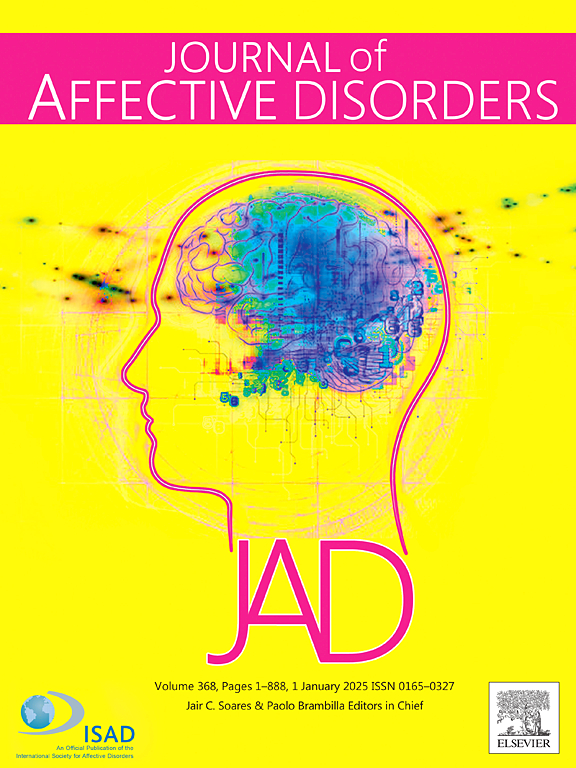儿童期受虐待的成年人的联合纤维和联合纤维的广泛显微结构变化:一项自动纤维定量研究
IF 4.9
2区 医学
Q1 CLINICAL NEUROLOGY
引用次数: 0
摘要
儿童虐待(CM)是一个普遍存在的全球性问题,它增加了情绪失调和奖励依赖相关行为问题的风险,并显著影响脑白质(WM)的微观结构。然而,CM个体WM微观结构改变的具体改变尚不清楚。方法采用自动纤维定量方法研究WM细粒度微结构变化,并评估其与情绪失调和奖励依赖的相关性。收集1000名儿童创伤问卷(CTQ-SF)得分。其中,CTQ-SF≥38者21例为CM组,25≤CTQ-SF≤37且各分量表得分均未超过阈值者22例为无CM组。利用支持向量回归模型探讨细粒度扩散张量图像参数与情绪失调或奖励依赖之间的关系。结果CM组在钩状、弓形、额枕下、胼胝体小束和下纵束等联合纤维和交联纤维的淋巴结发生改变。CM组左弓状束额顶叶径向扩散率与奖励依赖性呈显著负相关。左侧额枕下束平均弥散度和CM亚型经验可作为情绪失调的预测因子。局限性:本横断面研究不允许明确地建立因果关系。结论了解与儿童虐待相关的神经生物学改变,可能会增加早期筛查与情绪失调和奖励依赖相关的行为问题风险的紧迫性。本文章由计算机程序翻译,如有差异,请以英文原文为准。
Extensive microstructural changes in association and commissural fibers in adults with childhood maltreatment: An automated fiber quantification study
Background
Childhood maltreatment (CM) is a pervasive global issue with heightened risk of both emotion dysregulation and reward dependence related behavioral problems and significantly affects microstructure of brain white matter (WM). Yet the specific alterations of WM microstructure alterations in CM individuals remain unclear.
Methods
We explored fine-grained WM microstructure alterations using automatic fiber quantification and assessed their correlation with emotion dysregulation and reward dependence. Childhood Trauma Questionnaire-Short Form (CTQ-SF) scores were collected from 1000 subjects. From these, 21 subjects with CTQ-SF ≥ 38 were selected as the CM group, and 22 subjects with 25 ≤ CTQ-SF ≤ 37 and scores of all subscales not exceeding the thresholds as the no CM group. Support vector regression models were utilized to explore the relationship between the fine-grained diffusion tensor images parameters and emotion dysregulation or reward dependence.
Results
The CM group exhibited alterations in the nodes of several association and commissural fibers, including uncinate, arcuate, inferior fronto-occipital, callosal forceps minor, and inferior longitudinal fasciculus. Remarkably, radial diffusivity in frontoparietal segment of left arcuate fasciculus were significant negatively correlated with reward dependence in the CM group. Mean diffusivity of left inferior fronto-occipital fasciculus and CM subtypes experiences could be used as predictors for emotion dysregulation.
Limitations
This cross-sectional study did not allow the establishment of a causal relationship unequivocally.
Conclusions
Understanding the neurobiological alterations associated with childhood maltreatment provides a clue for potentially increasing the urgency of early screening for risk of behavioral problems related to emotion dysregulation and reward dependence.
求助全文
通过发布文献求助,成功后即可免费获取论文全文。
去求助
来源期刊

Journal of affective disorders
医学-精神病学
CiteScore
10.90
自引率
6.10%
发文量
1319
审稿时长
9.3 weeks
期刊介绍:
The Journal of Affective Disorders publishes papers concerned with affective disorders in the widest sense: depression, mania, mood spectrum, emotions and personality, anxiety and stress. It is interdisciplinary and aims to bring together different approaches for a diverse readership. Top quality papers will be accepted dealing with any aspect of affective disorders, including neuroimaging, cognitive neurosciences, genetics, molecular biology, experimental and clinical neurosciences, pharmacology, neuroimmunoendocrinology, intervention and treatment trials.
 求助内容:
求助内容: 应助结果提醒方式:
应助结果提醒方式:


